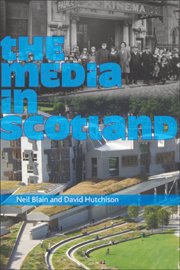Book contents
- Frontmatter
- Contents
- Preface
- Framing the Discussion
- The Historical Context
- Screen and Sound
- 7 Three Ring Circus: Television Drama about, by and for Scotland
- 8 ‘Nae Bevvying, Nae Skiving’: Language and Community in the Scottish Soap Opera
- 9 Broadcast Comedy
- 10 Contemporary Scottish Cinema
- 11 Radio and Popular Music
- Themes and Futures
- Select Bibliography
- Notes on Contributors
- Index
11 - Radio and Popular Music
from Screen and Sound
Published online by Cambridge University Press: 05 August 2013
- Frontmatter
- Contents
- Preface
- Framing the Discussion
- The Historical Context
- Screen and Sound
- 7 Three Ring Circus: Television Drama about, by and for Scotland
- 8 ‘Nae Bevvying, Nae Skiving’: Language and Community in the Scottish Soap Opera
- 9 Broadcast Comedy
- 10 Contemporary Scottish Cinema
- 11 Radio and Popular Music
- Themes and Futures
- Select Bibliography
- Notes on Contributors
- Index
Summary
INTRODUCTION: ANOTHER COUNTRY, ANOTHER MUSIC
The closure of a country music radio station, which was devised and programmed by an American and only available digitally, and its relaunch two months later under a new name in Nashville, Tennessee, might seem to have little to do with the health of Scotland's radio industry. Still less might it be expected to offer any insight into the characteristics of the Scottish music business. But the sudden switch-off of 3C by Emap plc on 27 March 2007 is subtly indicative of something about the state and future of both these sectors of the creative economy in Scotland.
3C announced on air on 26 March 2007 that the closure was ‘the result of a brand review undertaken by our parent company’. Emap had acquired 3C as part of its takeover of Scottish Radio Holdings plc (SRH) for £280 million in cash in August 2005 (Emap 2006: 6). SRH — founded in 1991 from a merger of Radios Clyde, Forth, Tay and Northsound — had launched 3C from Radio Clyde's Clydebank studios in 2000. It was broadcast initially on the Internet and as one of the extra stations on SRH's local DAB digital radio multiplex run by SRH-subsidiary Score Digital, and from 2004 on the Freeview digital terrestrial television platform across the UK as well — thus making it the first national country music service in the history of UK radio and the first UK national radio station to be based in Scotland.
- Type
- Chapter
- Information
- The Media in Scotland , pp. 166 - 180Publisher: Edinburgh University PressPrint publication year: 2008



